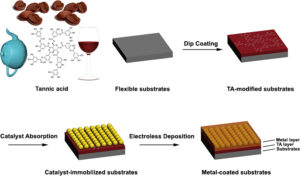Red wine spills and wearable technology: Turning failure into success
Research and impact 30 July 2019
Spilling red wine – it’s happened to most of us at some point. It can be highly embarrassing and can ruin clothing, even furniture. A red wine stain is, generally, considered a bad thing.

Thankfully Dr Xuqing Liu, Research Fellow in Textile Bioengineering and Science in the School of Materials, and his team believe that the ‘failure’ of a wine spill can be turned into a ‘success’ – a success for the next generation of wearable technology.
Dr Liu recently told the School of Materials blog how his research into wearable devices is assisting the elderly and disabled; now he explains how his other research, inspired by red wine, could lead to new wearable devices that are flexible and breathable…
Hi Xuqing, please could you tell us a little about this research?
For wearable devices, soft conductive materials are fundamental to stable performance, and advanced materials science determines advanced performance. Conductive yarns are used as the decisive material in the field of wearable devices, but there has always been a problem that the conductive coating on the surface of the fibre is easily peeled off – mainly because there is no strong bonding force between the conductive metal layer and the yarn.
We have therefore developed a high-quality conductive yarn using tannic acid – which is widely used in red wine – as a binder between the conductive layer and the fibre. We have also studied the condensed state of nanoclusters in the microscopic world, and proposed a soap foam type to explain the agglomeration state of nanoparticles.

What could this mean for the public?
We used an advanced scanning electron microscopy to investigate metal nanostructures and proposed a new soap bubble model to explain the condensed state of the microcosm. Through our proposed soap bubble model, the public can better understand the composition of matter at the nanoscale through the macroscopic world phenomenon, although there is no advanced electron microscope.
What impact could the research have in the future?
Our results have led to a significant reduction in the manufacturing costs of wearable devices, making the price of wearable devices more acceptable to the public. It also increases the life of wearable devices, which again makes them more cost efficient.
How is this research unique?
This research is inspired by red wine stains – a common problem for many people. The embarrassment this can cause has inspired us to use the science involved to make wearable devices. It has also got me thinking philosophically: everything has two sides – sometimes the side of failure, but from another perspective it may turn into a success.
Read more about Dr Liu’s research on the University news pages.
Images: Dr Xuqing Liu, Tobias Toft





Leave a Reply